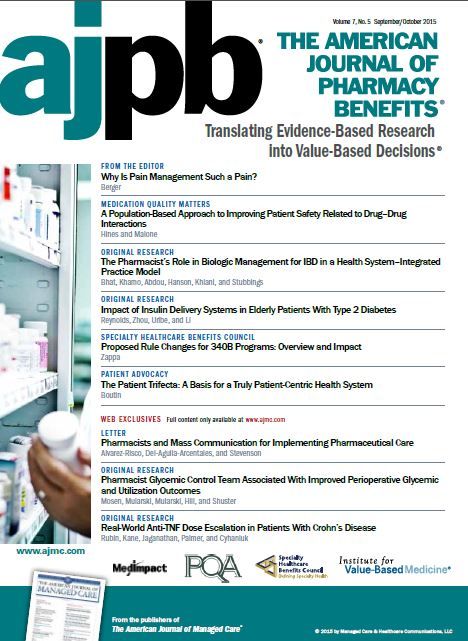Publication
Article
AJPB® Translating Evidence-Based Research Into Value-Based Decisions®
The Patient Trifecta: A Basis for a Truly Patient-Centric Health System
Author(s):
It's time to reconfigure our health system to address patients' desired clinical outcomes within the context of their goals, aspirations, and personal circumstances.
The Institute of Medicine (IOM) pointed out back in 2012 that engaging patients and their families in the management of their conditions leads to better outcomes and can also reduce costs. To facilitate these interactions, the IOM recommended that healthcare organizations gather and assess patients’ perspectives and then use the information to improve delivery of care.
1
Yet instead, treatment decisions are often based on clinical outcomes without factoring in the patient perspective. Too often longevity is confused with living.
We need an approach to healthcare that ensures the most appropriate clinical outcomes are balanced against patients’ personal circumstances and life goals. The confluence of all 3 factors makes up what the National Health Council calls the “Patient Trifecta.”
All 3 of the aforementioned elements are important, though the weight ascribed to them varies by individual on a case-by-case basis—only the patient and their family caregivers know how best to align the 3. With this in mind, the health system will only become more effective and efficient by working with patients to balance these 3 major factors and then providing a care plan that helps to address them.
Clinical Outcomes
The first element of the trifecta is identifying the potential clinical outcome. However, it is important to recognize that for the 133 million people with chronic diseases and disabilities, the reality is that a cure is not an option; it is only how to maximize the remaining quality of life.
My father was diagnosed with lung cancer, the leading cause of cancer deaths in the United States.2 The treatment plan he received did not extend his life, and he suffered through months of agonizing treatments for a condition with no cure. Too often, the clinical outcome trumps a patient’s personal goals, and in my father's situation, the best care should have been less care.
Personal Circumstances
Overlaying the desired clinical outcomes is the realization that each patient has unique, and sometimes complex, personal circumstances. The second element of the trifecta—knowing socioeconomic factors such as whether the patient owns a home, has a car, is gainfully employed, and his or her level of education—is powerful information for creating a realistic treatment plan that envelopes an individual’s life goals and achievable clinical outcomes.
Take a woman in northern rural Maine who works part time, is raising 2 elementary school-age children, and is the family caregiver for her mother, who was diagnosed with Alzheimer’s disease. In addition, this woman herself has breast cancer, has to drive 8 hours to the closest university medical center to get the care needed for herself and her mother, and moreover, has limited financial resources and low health literacy skills. All of these factors impact her ability to meaningfully care for her family and herself.
Life Goals
People do not live to get their blood work or other medical tests done. They live each day in anticipation of an important milestone in their life, including graduation, marriage, the birth of a child, a better job, or a much anticipated trip. We all have personal aspirations, and it is these goals that define our individual life journey. When healthcare providers don’t understand the patient’s goals, the treatment plan can take the aspect of “living” out of life.
For example, a woman diagnosed with stage-4 colon cancer at age 48 had a dream to compete in the Ironman World Championship in Kona, Hawaii. Though her cancer had metastasized to her liver, she fought to achieve her life goal, and against all odds, she crossed the finish line of the Ironman World Championship at age 50.
3
Building a Patient-Centric Health System
Building a delivery system that incorporates the Patient Trifecta for the 20% of the population who drive 80% of the healthcare costs would go a long way toward moving our acute care system to a preventive and chronic care model.4 This would also result in care plans that lead to greater compliance and adherence, creating a transformation in both patient and provider satisfaction, with subsequently better population health outcomes at lower costs.
We need to aggressively reshape the healthcare environment and push forward a bolder vision of health delivery based on the Patient Trifecta. If not, we will continue to live with the health system status quo, never truly recognizing the complex personal needs of people with chronic conditions. That is not a situation the patient community or other stakeholders want or will be satisfied with.







